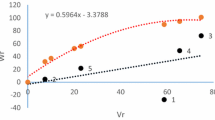Summary
In winter wheat (Triticum aestivum L.), the development of a methodology to estimate genetic divergence between parental lines, when combined with knowledge of parental performance, could be beneficial in the prediction of bulk progeny performance. The objective of this study was to relate F2 heterosis for grain yield and its components in 116 crosses to two independent estimates of genetic divergence among 28 parental genotypes of diverse origins. Genetic divergence between parents was estimated from (a) pedigree relationships (coefficients of kinship) determined without experimentation, and (b) quantitative traits measured in two years of field experimentation in Kansas and North Carolina, USA. These distances, designated (1 -r) and G, respectively, provided ample differentiation among the parents. The 116 F2 bulks were evaluated at four locations in Kansas and North Carolina in one year. Significant rank correlations of 0.46 (P = 0.01) and 0.44 (P = 0.01) were observed between G and grain yield and kernel number heterosis, respectively. Although (1 -r) was poorly associated with grain yield heterosis, G and midparent performance combined to account for 50% of the variation in F2 yields among crosses when (1 -r) was above the median value, whereas they accounted for only 9% of the variation among crosses when (1-r) was below the median. Midparent and (1 -r) had equal effects on F2 grain yield (R 2= 0.40) when G was greater than the median value. A breeding strategy is proposed whereby parents are first selected on the basis of performance per se and, subsequently, crosses are made between genetically divergent parents that have both large quantitative (G) and pedigree divergence (1 -r).
Similar content being viewed by others
References
Arunachalam V, Bandyopadhyay A, Nigam SN, Gibbons RW (1984) Heterosis in relation to genetic divergence and specific combining ability in groundnut (Arachis hypogaea L.). Euphytica 3:33–39
Busch RH, Janke JC, Frohberg RC (1974) Evaluation of crosses among high and low yielding parents of spring wheat (Triticum aestivum L.) and bulk prediction of line performance. Crop Sci 14:47–50
Cervantes T, Goodman MM, Casas E, Rawlings JO (1978) Use of genetic effects and genotype by environmental interactions for the classification of Mexican races of maize. Genetics 90:339–384
Cowen NM, Frey KJ (1987a) Relationships between three measures of genetic distance and breeding hehavior in oats (Avena sativa L.). Genome 29:97–106
Cowen NM, Frey KJ (1987b) Relationship between genealogical distance and breeding behavior in oats (Avena sativa L.) Euphytica 36:413–424
Cox TS, Murphy JP, Rodgers DM (1986) Changes in genetic diversity in the red winter wheat regions of the United States. Proc Natl Acad Sci USA 83:5583–5586
Cregan PB, Busch RH (1977) Early generation bulk hybrid yield testing of adapted hard red spring wheat crosses. Crop Sci 17:887–891
Cregan PB, Bush RH (1978) Heterosis, inbreeding, and line performance in crosses of adapted spring wheats. Crop Sci 18:247–251
Cress CE (1966) Heterosis of the hybrid related to gene frequency differences between two populations. Genetics 53:269–274
Ghaderi A, Adams MW, Nassib AM (1984) Relationship between genetic distance and heterosis for yield and morphological traits in dry edible bean and faba bean. Crop Sci 24:37–42
Goodman MM (1972) Distance analysis in biology. Syst Zool 21:174–186
Hanson WD, Casas E (1968) Spatial relationship among eight populations Zea mays L. utilizing information from a diallel mating design. Biometrics 24:867–880
Isleib TG, Wynne JC (1983) Heterosis in testcrosses of 27 exotic peanut cultivars. Crop Sci 23:832–841
Jatasra DS, Paroda RS (1983) Genetic divergence in wheat. Indian J Genet 43:63–67
Jinks JL (1983) Biometrical genetics of heterosis. In: Frankel R (ed) Heterosis. Reappraisal of theory and practice. Springer, Heidelberg Berlin New York pp 1–46 (Monographs on the-oretical and applied genetics 6)
Lefort-Buson M, Guillot-Lemoine B, Dattee Y (1986) Heterosis and genetic distance in rapeseed (Brassica napus L.). Use of different indicators of genetic divergence in a 7 × 7 diallel. Agronomie 6:839–844
Lefort-Buson M, Dattee Y, Guillot-Lemoine B (1987) Heterosis and genetic distance in rapeseed (Brassica napus L.): Use of kinship coefficient. Genome 29:11–18
Mahalanobis PC (1936) On the generalized distance in statistics. Proc Natl Inst Sci India 2:49–55
Malecot G (1948) Les mathématiques de l'hérédité. Masson, Paris
Maluf WR, Ferreira PE, Miranda JEC (1983) Genetic divergence in tomatoes and its relationship with heterosis for yield in F1 hybrids. Rev Brasil Genet 6:453–460
McCammon RB, Wenninger G (1970) The dendograph. State Geological Survey, University of Kansas Computer Contr. No. 38, Lawrence
Murphy JP, Cox TS, Rodgers DM (1986) Cluster analysis of red winter wheat cultivars based upon coefficents of parentage. Crop Sci 26:672–676
Ramanujam S, Tiwari AS, Mehra RB (1974) Genetic divergence and hybrid performance in mung bean. Theor Appl Genet 45:211–214
Shamsuddin AKM (1985) Genetic diversity in relation to heterosis and combining ability in spring wheat. Theor Appl Genet 70:306–308
Snedecor GW, Cochran WG (1980) Statistical methods. The Iowa State Univ Press, Ames
Souza EJ (1988) Measures and applications of genetic relationships in oats. PhD dissertation, Cornell University, Ithaca/ NY
Zadoks JC, Chang TT, Konzak CF (1974) A decimal code for the growth stages of cereals. Weed Res 14:415–421
Author information
Authors and Affiliations
Additional information
Communicated by A. R. Hallauer
Paper No. 12162 of the Journal Series of the North Carolina Agricultural Research Service, Raleigh, NC 27695-7643, and Contribution No. 89-396-J of the Kansas Agricultural Experiment Station, Manhattan, KS 66506
Rights and permissions
About this article
Cite this article
Cox, T.S., Murphy, J.P. The effect of parental divergence on F2 heterosis in winter wheat crosses. Theoret. Appl. Genetics 79, 241–250 (1990). https://doi.org/10.1007/BF00225958
Received:
Accepted:
Issue Date:
DOI: https://doi.org/10.1007/BF00225958



